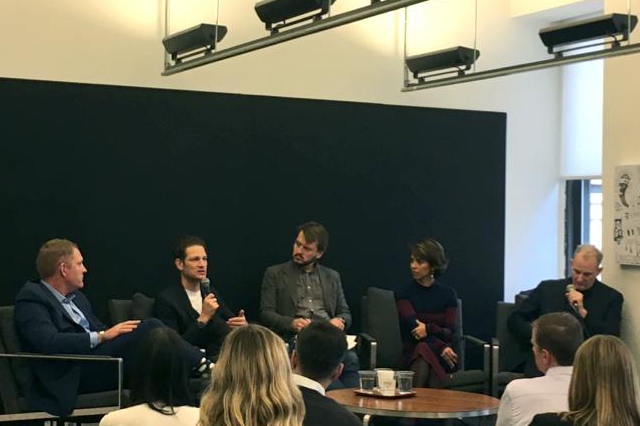The FGRT team attended the Digital Emotional Intelligence breakfast panel, hosted by Avery Dennison and EVRYTHNG, last week in New York City. The event was held at Avery Dennison’s Customer Design and Innovation Center, a multipurpose center that serves as a collaborative design space, think tank and creative space for teams.
The panel discussion focused on connectivity, digitalization and data. Industry leaders spoke about how digital technologies and data are being used to understand human behavior and emotions across physical and digital channels.
The panel was chaired by Piers Fawkes, CEO and Founder of daily news site PSFK. The panelists were Uri Minkoff, CEO of Rebecca Minkoff; Bill Toney, VP of Global RFID Market Development at Avery Dennison; Andy Hobsbawm, Cofounder and CMO at EVRYTHNG; and Liz Bacelar, Founder of innovation firm TheCurrent and global event series Decoded Fashion.
There Is an Opportunity for Personalization on the Path to Purchase
The path to purchase is no longer black-and-white, Uri Minkoff, CEO of Rebecca Minkoff, said. Today, consumers can choose from a number of purchase journeys, whereas in the past, the path to purchase was limited to a physical store or a catalog. Technology tools provide consumers with increasing options on the path to purchase within nearly every area of their life. For example, cameras and geolocation tracking have enabled consumers to make purchases while they are on the subway, Minkoff noted. Brands and marketers can use this location data to understand their customers and continue to personalize experiences for them. Additionally, shoppers have more opportunities to actually make a purchase—online shopping is not confined to a desktop anymore.
The path to purchase expands with technology, Minkoff said, adding that marketers and retailers are able to continually iterate as technology is developed to take advantage of new opportunities to reach consumers on their retail journey. For example, the new iPhone X includes a depth-to-field measurement for facial recognition—a new technology industry feature. Minkoff asked, “Can this provide opportunities for eyewear recommendations based on the depth of one’s face? Will this have applications for beauty?” He added that augmented reality creates new retail opportunities as well, and that new technologies are being developed to layer and personalize the purchasing journey.
Liz Bacelar, Founder of TheCurrent and Decoded Fashion, said that all consumers, not just young consumers, are self-focused. She said that today’s consumers want and expect to be known and recognized when they enter a store, which provides retailers and brands with an opportunity for personalization.
Bill Toney, VP of Global RFID Market Development at Avery Dennison, noted that, in 2016, 32% of all Black Friday transactions started or ended on mobile. That rate was up 32% year over year, he said, providing more evidence that the consumer’s path to purchase has more touchpoints and opportunities for personalization.
Data Is a Competitive Advantage When It Comes to Creating Emotional Connections
The panelists discussed how unlocking and using data is a competitive advantage today. Andy Hobsbawm, Cofounder and CMO of EVRYTHING, said that change is being driven by unlocking new data sources. There is power in measuring, using and understanding data to create emotional connections, he said. Hobsbawm cited Apple as an industry success story, saying that the company has unlocked its data and knows practically 100% of its customers and 100% of its supply chain. He suggested that there are only a few companies that use data and personalization to offer something unique and relevant; these include Apple, Netflix, Amazon, Google and Facebook. When personalization is done correctly, it can generate an emotional response, he said, adding, “I know it is an algorithm, but I actually feel like Netflix recommendations are from a friend.”
Bacelar said that Stitch Fix, a subscription apparel company, is not really a clothing company, but a data company. She said, “They mine the data and they sell the knowledge of you to you.” Bacelar argued that while not every company should have a subscription model, companies should be talking to their customers and making a connection in the personalized way that Stitch Fix does, by using data in a smart way.
Consumers’ Willingness to Share Information and Companies’ Personalization Efforts Will Allow for an Explosion of Microbrands
Minkoff said that consumers are increasingly willing to share information about themselves. They are self-identifying in terms of “fashionistas,” “foodies” and “health-conscious consumers,” for example. Consumers are also sharing information such as anniversaries, birthdays and geolocation data, which can give brands as many as six data points to use in targeting personalized offerings. Many brands now have precise information that they can use to create unique, differentiated products for each and every need, Minkoff said, such as “the exact moisturizer that one needs for [his] handlebar moustache if [he] lives in Brooklyn…based on the weather.”
Minkoff said that, for brands, the technology process is iterative, and he likened it to the development of wearable technology. A few years ago, consumers were wearing the actual devices, but now they are wearing tech-enabled fashions that they actually want wear, he said.
Minkoff predicted that there will be an explosion of microbrands in the future, due to consumers sharing their information and companies offering differentiation. He theorized that Amazon may give microloans to these companies to finance their inventory holding. Minkoff added that technology will help enable a dialogue with shoppers pre- and postpurchase and that brands’ success in the future will not be based on “who has the best item,” but on who has the most meaningful connection with their customers.
